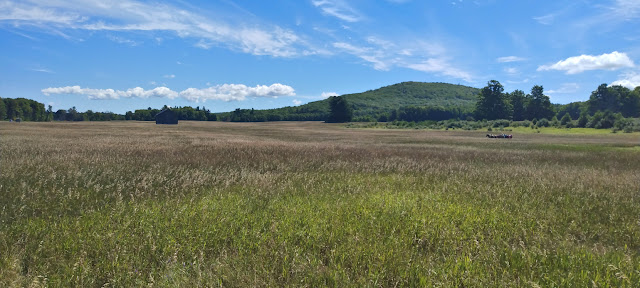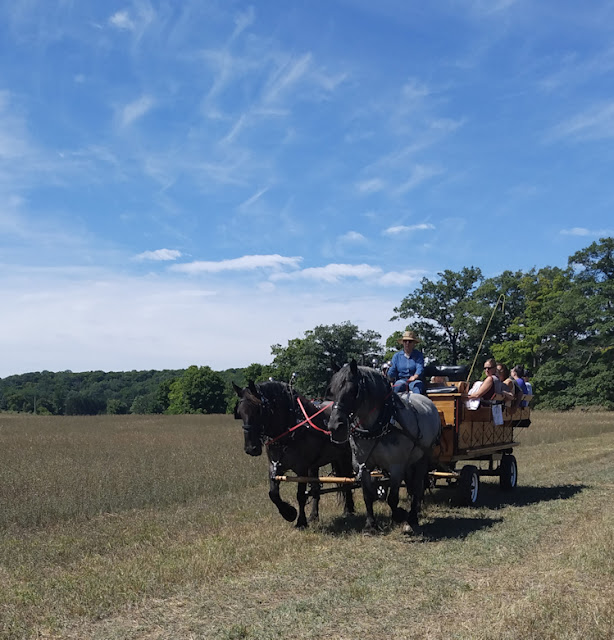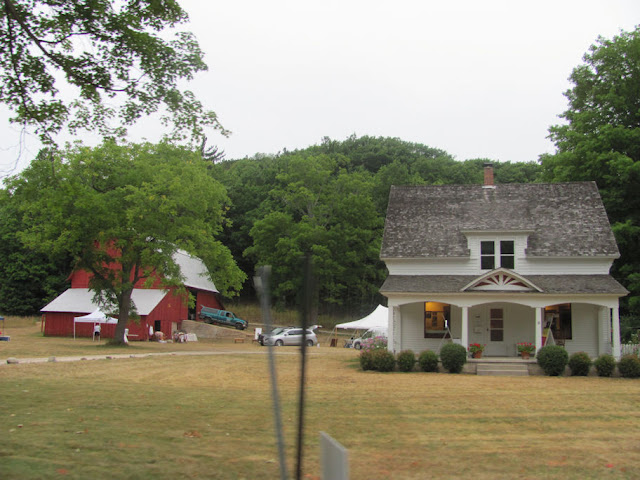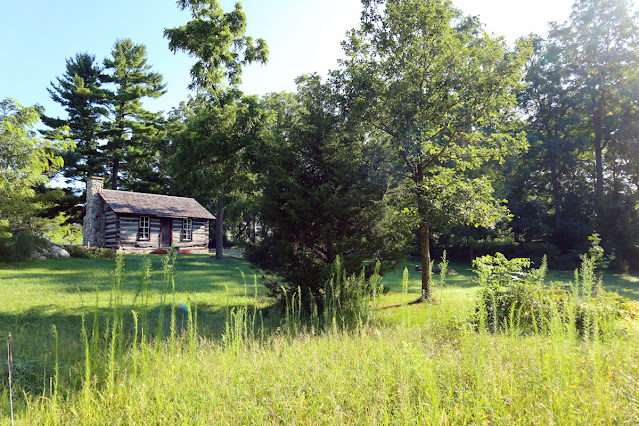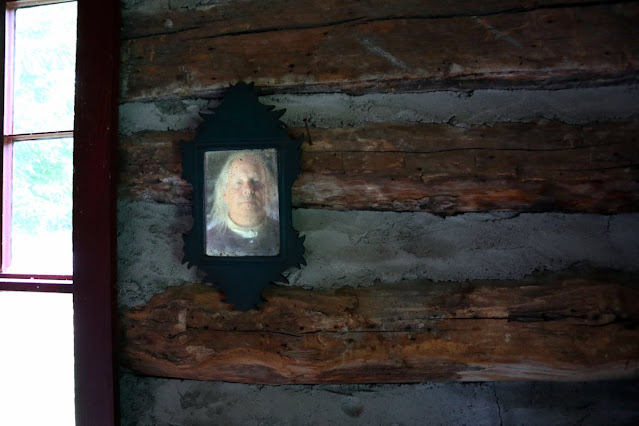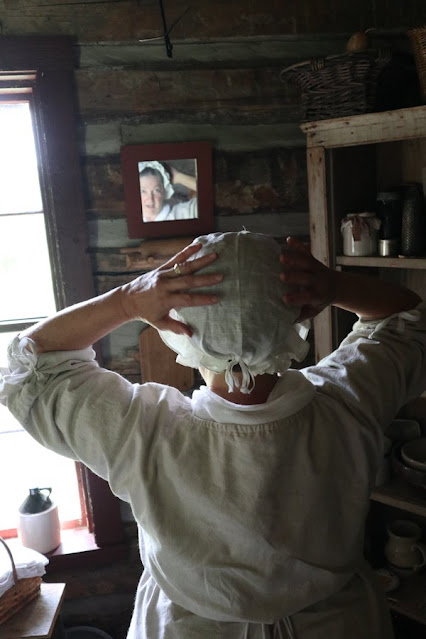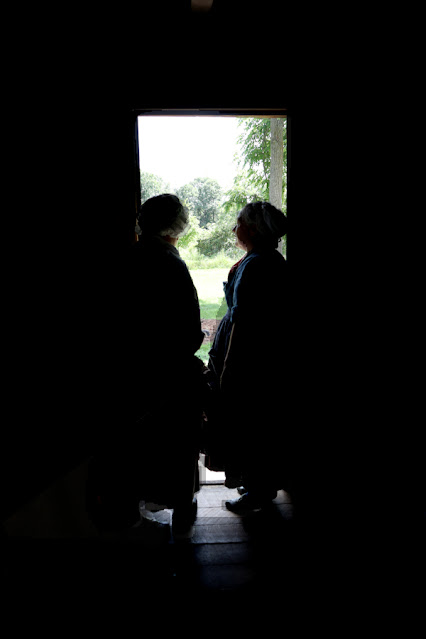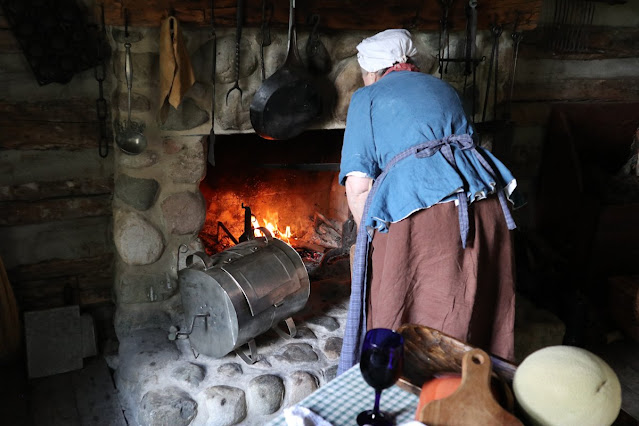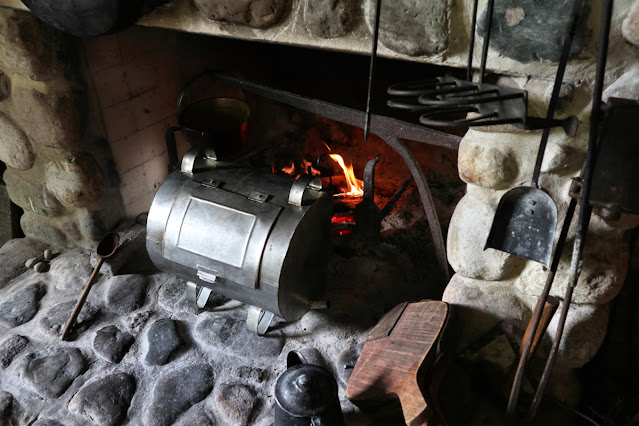This is the end...beautiful friend...
 |
A slight foggy dew hides the sky of blue on the morning of what promises to be
a hot and muggy day. |
 |
Zouaves - I don't believe this group
has missed a single event here in ten years.
I thank you good folks. |
Every year we try to come up with something new and different for our Port Sanilac Civil War reenactment. I mean, as the host of the event (with my friend Jackie co-hosting it with me this year), I can come up with pretty much anything, as long as it's historical.
So this year was our attempt to reenact the Battle of Antietam (also known as the Battle of Sharpsburg).
"Attempt" being the key verb here.
It ended up being a sort of tactical with a few cannon firings and musketed soldiers hiding behind buildings and taking shots at each other.
The battle could have / should have been something greater, but it seems too many reenactors had to stay home and cut their grass or plan for something else, or maybe they're still living in the pandemic age, for we had a very poor turnout.
Yeah, I can't help but be a bit snarky.
Ah, well, at least those who did show made their best effort.
To be honest, even the smallest of battle representations usually please the public, for it's not often one gets to see (and hear!) historic cannons and guns firing:
 |
Cannon fire started the day.
There were two cannons firing - Boom! Boom! - one right after the other!
 |
 |
Some of the men in blue skirmishing.
Yeah...the crowd still really enjoyed it.
 |
 |
| The guys did a great job! |
As a historic reenactor, could I be more proud of our dog when you see how he reacts to cannon fire?
Yup - doesn't bother him at all.
So 4th of July fireworks are like cap guns to him!
Yeah...much of his early years were spent at reenactments...
My wife?
She don't mind 'em much either!
lol
 |
My beautiful and patriotic wife trying to keep our dog, Paul Anka,
calm during the musket and cannon firing.
Wait---he doesn't seem to mind---not at all. Cannons and muskets are
more or less just a bit of an annoyance for him. |
The cannons and musketry didn't bother me, either.
 |
Hot...muggy...and pretty tired. So I took a quick nap.
My wife has a comfortable lap, especially when she's wearing layers.
I dreamed of America (lol)
|
Jackie, who you see with us often during our colonial cabin excursions, was the hostess for an 1860s mourning presentation.
She did an amazing job!
 |
| Jackie in 2nd stage mourning. |
She has that wry sense of humor that gave the dour subject a bit of light.
She covered the fashion - telling of the different stages of mourning women went through and what they wore for each stage.
Jackie went on to teach all about the mourning etiquette of the time and of the various ways others would respond to death - how a friend or relative of the mourner may respond to her plight.
She also explained that death happened quite frequently for younger people during the 1860s, and it was much more commonplace at a younger age than today; the infant mortality rate was extremely high. Unfortunately, death during childbirth was the number one cause of a woman's death and how death in the 19th century was much more an accepted part of life.
(Here is something from "Rachel Weeping: Mourning in 19th Century America" by Karen Rae Mehaffey): 'Americans responded to death as a constant companion, and even embraced it with resignation and ritual. Americans...were intimately acquainted with death. Victorians embraced mourning as a sub-culture. It impacted how people dressed, how they behaved in society, and even how they decorated their homes.'
'Women were responsible for mourning in the family, and carried the responsibility of preparing mourning garments and making sure everyone was dressed properly.'
An excellent and informative presentation, and she did a great job holding the audience's attention.
One of the things we do that I am most proud of is our fashion show. Our fashion show is a bit different than most that we see - not better or worse, just different. I came up with the idea years ago of having the participants - models, if you like - speak on their own behalf of not only about their own clothing, but of why they were wearing the fashion and style they had on.
 |
A few of the models for the fashion show.
However, our fashion shows are not typical of most. We try to keep ours'
focused as much on history as we do fashions.
We've been doing it this way for at least a decade. |
What was the reason behind the clothing is always our main theme. But this year we took the fashion show down a different path: each "model" became a citizen of Sharpsburg, Maryland, where Antietam took place in 1862.
However, Jackie, who had just come out of mourning (lol), put on her yellow dress and gave a basic outline of what women wore, including (men are to cover their eyes and refrain their thoughts here) her underpinnings:
 |
Jackie is not shy.
No, not at all... |
Jackie researched many different citizens and allowed us to choose who we wanted to be. She had a paragraph for each citizen, so learning "our part" was relatively simple.
So each each of us began by speaking about ourselves (who we were portraying) and our clothes, of our lives, our occupations, and how the war affected and afflicted us. This seemed to bring it all home for the audience watching; it helps to get them into thinking about how war affects everyone.
For instance, I portrayed Martin Eakle, a local miller who ran a gristmill. So I began my speech talking about my clothing - my linen farming clothing - which lead to me speaking on gristmills and of their importance to the local community. But during the Battle of Antietam - - -
 |
" I " drove my horse and cart out to the Union men under
heavy fire to give out biscuits, ham, and “good rye whisky.”
I also took several wounded men to the nearby field hospital.
I made numerous trips to the field hospital that day, wagon
loaded with wounded soldiers. I was very lucky that I did
not get wounded, though one of my horses did. |
118 years after the Battle of Antietam, an article titled “County Man Antietam’s Unknown Hero” appeared in the May 10, 1980, Daily Mail, a newspaper published in Hagerstown, Md., 12 miles north of Sharpsburg. A descendant of the Eakle family surfaced with substantial evidence that the hero was (ahem) Martin Eakle of Eakles Mill.
Shortly after the battle, a member of the Eakle family had had the brave exploits printed in a four-page pamphlet, “Martin Eakle at Antietam.” The small publication, which mentioned an eyewitness account, was given to family members.
Yeah...I didn't realize I was portraying such a hero!
 |
Margaret Roulette, with her husband, William, along with their five children,
lived on a farm bordered by the Sunken Road, now known as Bloody Lane
because of the fierce fighting that occurred there, and they remained in their
dark cellar nearly the entire time the battle was going on. |
The Roulette's had beehives, which somehow got overturned during the fighting, and the angry insects attacked the men of the 132nd Pennsylvania Infantry, adding to their discomfort.
Their farm was also used as a field hospital by the Union Army.
Theresa Kretzer and her family chose to remain in Sharpsburg during the battle rather than flee like so many others. In fact, neighbors chose the Kretzer home as a place of refuge because of its large size and the thick stone walls. Even a few Confederate soldiers sought refuge there.
 |
"A number of babies were there, and several dogs, and every time the firing
began extra hard the babies would cry and the dogs would bark. Often the reports
were so loud, they shook the walls. Occasionally a woman was quite unnerved
and hysterical, and some of those old-aged men would break out in prayer."
Theresa Kretzer |
Dr. Mary Walker was an American abolitionist, prohibitionist, prisoner of war, and surgeon. She is the only woman to ever receive the Medal of Honor.
 |
She attempted to join the Union Army at the outbreak of the American Civil War
and was denied. She served as a surgeon at a temporary hospital in Washington, D.C. before being hired by Union Forces and assigned to Army of the Cumberland and
later the 52nd Ohio Infantry, becoming the first female surgeon in the US Army. |
After the war, she was approved for the Medal of Honor, for her efforts to treat the wounded in battle and across enemy lines during the Civil War.
Sarah Emma Edmondson was born in New Brunswick, Canada in December of 1841. Her father was a farmer who had been hoping for a son to help him with the crops; as a result, he resented his daughter and treated her badly. In 1857, to escape the abuse and an arranged marriage, Edmondson left home, changing her name to Edmonds.
Edmonds lived and worked in the town of Moncton for about a year, but always fearful that she would be discovered by her father, she decided to immigrate to the United States. In order to travel undetected and to secure a job, she decided to disguise herself as a man and took the name Franklin Thompson.
By the start of the Civil War in 1861, Edmonds was boarding in Flint, Michigan. An ardent Unionist, she decided that the best way to help would be to enlist under her alias, and on May 25, 1861, Edmonds was mustered into the 2nd Michigan Infantry as a 3 year recruit.
 |
In 1897, Edmonds was admitted into the Grand Army of the Republic,
the only woman member. |
In the spring of 1863, Edmonds and the 2nd Michigan were assigned to the Army of the Cumberland and sent to Kentucky. Edmonds contracted malaria and requested a furlough, which was denied. Not wanting to seek medical attention from the army for fear of discovery, Edmonds left her comrades in mid-April, never to return. “Franklin Thompson” was subsequently charged with desertion.
After her recovery, Edmonds, no longer in disguise, worked with the United States Christian Commission as a female nurse, from June 1863 until the end of the war. She wrote and published her memoirs, Nurse and Spy in the Union Army, the first edition being released in 1864. Edmonds donated the profits from her book to various soldiers’ aid groups.
On September 17, 1862, seventy-eight girls and young women were killed in an explosion at the Allegheny Arsenal in the Lawrenceville section of Pittsburgh, Pennsylvania – the worst civilian disaster of the Civil War.
The deaths of these young women were given little press coverage because the Battle of Antietam was fought the same day.
Employment at the arsenal as cartridge makers provided steady and reasonable income for young women and girls who were forced to find work to survive the war years. Employment at the arsenal enticed the young girls, widows, mothers, and wives who were struggling to support their families while their husbands, brothers, fathers, and sons were fighting in the Union Army.
 |
Mary Gardner - a survivor of the Alleghany Arsenal Explosion.
It was not considered proper for women to work outside the home,
but this work was allowed because it supported the war effort. |
Around 2pm, Joseph Frick was delivering wooden barrels of DuPont black powder in a horse-drawn wagon up the new stone road. Rachel Dunlap, an employee in the lab watched as Frick maneuvered his wagon into position to offload the barrels. Just then she saw a spark flash near the horse’s hooves (with iron horseshoes) and the iron-clad wagon wheels. Then she saw a sheet of flame. All it took was one tiny spark.
Many of the victims died in horrific ways. Witnesses reported bodies bursting in midair. A body does not survive 125,000 rounds of exploding ammunition, not to mention a couple hundred parrot-gun projectiles. Where the heat was most intense, there was nothing left but white bones in a heap.
Just as Antietam would prove the costliest day in military dead, the Arsenal explosion would produce the largest civilian death tally in the Civil War. The 34-acre complex became a grim public morgue with bodies laid out on wooden planks.
Recollections:
Ada Mumma was also a young child, living near Antietam Creek, when the armies descended. Her parents and grandparents initially planned to stay in their home during the battle, and Ada thought the novelty of hauling mattresses to the basement was quite exciting.
 |
"We had the orchard to cross first. the bullets were whistling all around us.
One went through my father’s hat and several went through the curtains on the
carriage. . . Then I heard a terrible whistling and an explosion which sent the
earth and stones in every direction, which I was told was a shell exploding." |
After the battle, surgeons turned Ada Mummer’s home into a hospital. Her grandmother returned first and found the farmhouse so crammed with wounded that she had to crawl in a window. Ada returned to the terrifying scene the next day:
"I could not sleep. I could hear those poor men calling for " 'water. . . for God’s sake, give me a drop of water.' ”
The Dunker German Baptist church is situated one mile north of the town of Sharpsburg, on the ground once occupied by the left wing of the Confederates at the battle of Antietam. During the battle the church was used as a make-shift fort by the Confederates, and was shelled by the Northern forces. Union Troops battled to take the church for their use and by the end of the battle, after the withdrawal of the Confederates, it is estimated that 12,000 casualties would occur within a ½ mile of the church. The people surrounding the church (congregants) were left with no crops, livestock, etc. Their homes were destroyed, barns looted and burned. The church seemed to be the center of the battle and showed its scars.
 |
Farmer David Long became an elder at age 25 and then a minister at age 30,
presiding over the Manor church for 25 years. |
Samuel and Elizabeth Mumma lived on a 150 acre farm with their 10 children, Samuel having inherited it from his father in 1850. It was Samuel who had given some of his land on which to build the Dunker Church.
As the armies began to move into place around Sharpsburg the Mummas were told they should leave. They gathered clothing and packed the family silver in a basket, but left everything behind as artillery fire broke out overhead. The parents and younger children travelled in a two horse cart while the older children walked, escaping to Manor Church, about four miles to the north.
 |
It was good that they did. Their home became the site of some of the earliest
fighting in the battle, and their buildings the only buildings on the
battlefield purposely destroyed in the fighting. The house, barn, and
two outbuildings were burned by withdrawing North Carolina troops to keep
them from sheltering Union sharpshooters. |
The Mummas returned to the loss of everything they owned, which they estimated as worth around eight to ten thousand dollars. Over the winter they lived on the Sherrick farm near the Burnside Bridge, and rebuilt in 1863. The current house was rebuilt on the original foundation. After the war the Federal government refused compensation for the Mummas’ loss because the damage was caused by Confederates, and compensation was only paid for damage caused by Federal troops.
My hat is off to Jackie for all she put into not only this fashion show, but also in her mourning presentation. And I know the audience, which was decently large, enjoyed it as well. They also had good questions - it's always a good presentation when you can get your audience to think and wonder.
So, now, onto a few of our other reenactor visitors:
 |
Carrie and her daughter Nadia were there as well,
and so was Carrie's husband, Ian. In fact, it was Ian who
put together Saturday's military skirmish. |
 |
Larissa and I under the fly of Jackie.
It was a very hot and muggy day and I felt no need to add to the heat
by wearing my coat - linen or not - just as men of that time would do.
We tend to forget that people of the 1860s were every bit as smart as
people are today, and would have taken care of cooling themselves
down much in the same way as those without a/c do today. If that meant to
wear less clothing, especially while in the home, then that's what would happen. |
 |
Cathy did an awesome portrayal of Dr. Mary Walker, and included many
replicated 19th century doctor and surgical implements in her presentation. |
 |
The Assenmacher parlor.
Yes, I said "parlor." It is probably as close as one might see a parlor setting
as can be done while camping. I commend them for the work they put into it. |
 |
| Sue did a great job with her flax break and teaching the public about the old flax process. |
 |
The wee ones always seem to "up the bar" at reenactments - they add that
"home-touch" of authenticity, in my opinion. |
 |
Roberto and Melody Aleman and their wee ones.
I love the fact that Roberto, a recent immigrant from Nicaragua,
portrays a Union soldier in the American Civil War.
I've known Melody since she was a tiny tot in elementary school. |
 |
"Gee!! I Wish I Were a Man! I'd join the Union Army!"
says Larissa as she gazes at her soldier friends. |
Since we had virtually no way of doing any sort of battle or skirmish scenario on Sunday, new 21st Michigan member Patrick took it upon himself to do a weapons demonstration for the public that came out to see us. And they very much appreciated what he did.
 |
Patrick during his weapons demo.
 | I commend Patrick, for he gave an excellent explanation about his gun and
how it was fired.
My hat is off to you, sir.
It was reminiscent of our very first Port Sanilac back in 2009 when we only
had three soldiers who did the same as Patrick.
The first and the last on nearly the same note.
 | My two oldest sons flank Jim Cary in 2009.
|
|
|
When the sun goes down, and the clouds all frown...
 |
And with that, the sun sets on Civil War Days at Port Sanilac.
Since 2009 we've been teaching the public about this part of American history.
The event slowly grew until the mid-teens when we had our largest and best
participation from the reenacting community. Since then it has been spiraling
downward to the less than two dozen total or so that came out this year,
and it was mostly civilians.
And now, Civil War Days at Port Sanilac is officially over.
No, it wasn't the woke/cancel culture crowd that did this event in - it was the
lack of participation from reenactors more than anything else.
So now there are just two - perhaps three - major Civil War events left within an
easy drive of Metro-Detroit.
How long until there's nothing left?
I certainly am glad I added Revolutionary War/Colonial to my living history,
for that period seems to be on the upswing and thriving.
The same for WWII for those who do that time period (of which I am not a part of). |
For those who have come out almost every year since the beginning - you know who you are - I am very appreciative and thankful. Honestly I am. We had a good run...in fact, I plan to put together a sort of "best of Port Sanilac" post sometime in the future - there are some great pictures from past experiences. Yeah... some truly amazing times: the Battle of Gettysburg, an authentic 1860s country fair, visits from President Lincoln, Battle of Bull Run, mourning, medical scenarios, a shotgun wedding, swimming in the lake while in 1860s swimwear and clothing, Battle of Antietam, amazing fashion show history lessons...even a period circus! So many great times.
Farewell to what was once an amazing event.
Well, my friends, until next time, see you in time.
Thanks to
B&K Photography, Larissa Fleishman, Ian Kushnir, and Sue Madonia for the use of their photos - between alla yours and mine, we got it covered.





